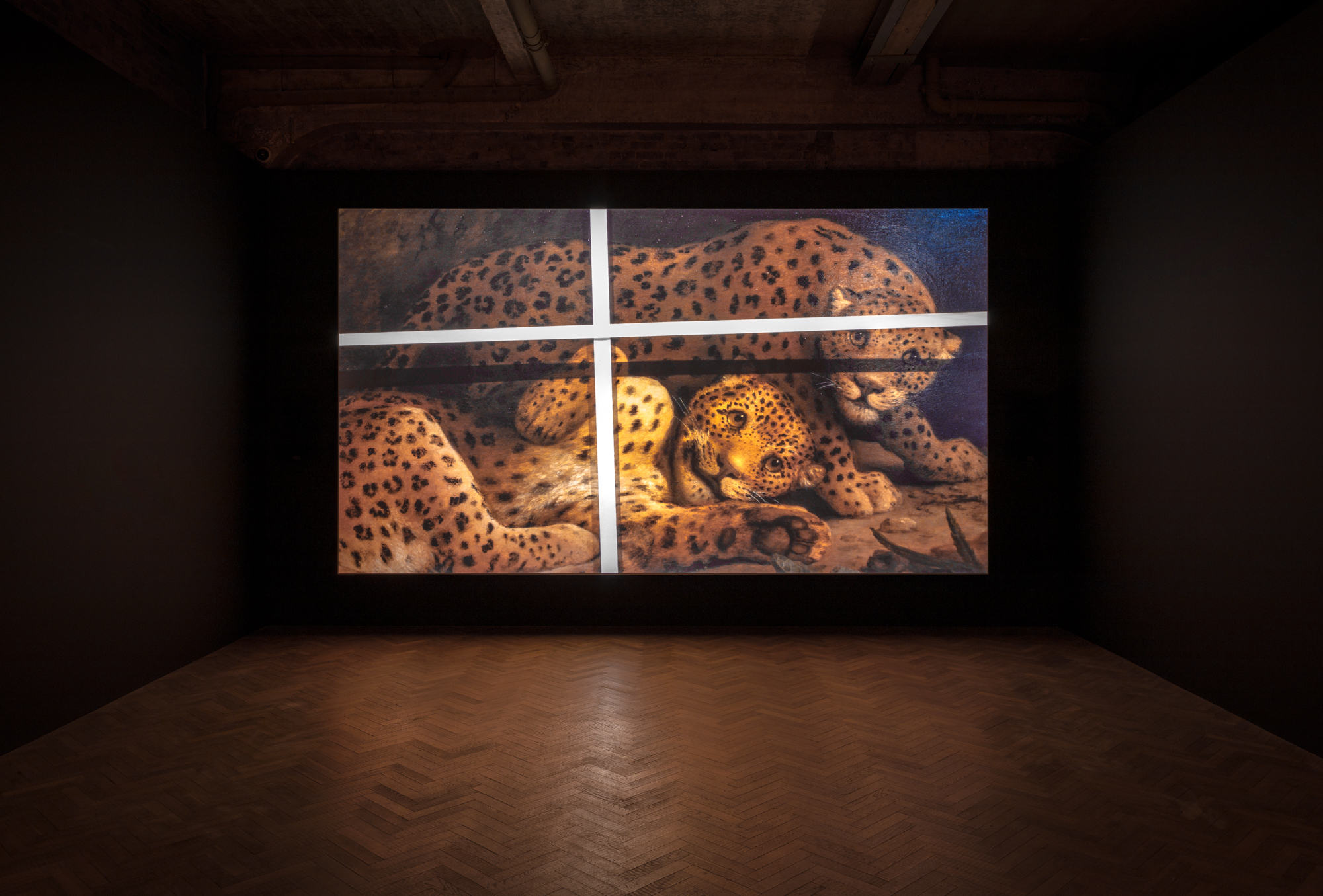


Thomas Dane Gallery, Pall Mall
--
National Galleries of Scotland, Edinburgh
27 April - 23 July 2022
Three years in the making, Amie Siegel’s latest film work, Bloodlines, is currently on view simultaneously in London and Edinburgh. The work enters the permanent collections at the Scottish National Gallery of Modern Art, thanks partly to support from us here at CAS. The projection there is at a grandiose, cinematic scale that immerses the viewer in the experience, making one hyper-aware of every meticulously captured detail, exhilarated as the camera soars over glorious rural landscapes.
The conceptual framework for the film is simple: through the autumn of 2019 to the spring of 2020, we follow paintings by George Stubbs from their owners’ homes to the exhibition at Milton Keynes Gallery and then back again. Many of these paintings still hang in the houses of the men who commissioned them in the 18th century. Acknowledged as one of the greatest painters of horses this country has ever produced, Stubbs made a career out of portraiture of thoroughbreds, commissioned by men who devoted their lives to breeding and racing horses.
In making Bloodlines, Siegel gained access to some of the great country houses in England and Scotland, only a few of which are ever open to the public. Into silent, often dust-sheeted homes, come the art handlers. Their brisk efficiency, and elaborately careful handling of the precious paintings is somehow at odds with the historic settings. Occasionally a dog pants noisily down a corridor to see what is happening. Out in the estates, beyond the mossy walls of the family seat, herds of deer careen elegantly beneath stands of trees; flocks of geese take off from a pond in the early morning. ‘Capability’ Brown landscapes - that came to define a particular vision of English life and relationship to nature – endure just as he conceived them. Developers and other such inconveniences of 20th or 21st century life exist only beyond the expansive boundaries of the property. One cannot deny the lyrical beauty of the vision.
Without a narrative voice-over, the soundtrack is occasionally taken over by a slightly ominous rumbling, at other moments fine clocks tick and chime in politely hushed tones on mantels and hall tables. We watch as a member of staff in one house carefully winds and re-sets a clock before replacing its glass case. Ritual, habit, roles, and hierarchies are essential elements of well-managed homes. Glimpses of the staff give an impression of pride in place and pride in service. Above all there is an all-pervading understanding that things have been managed in, more or less, the same way for the 250 years since Stubbs’ paintings.
In her film work, Siegel has often been concerned with the flows of material goods and capital across the world. In Quarry, 2015, which you might have caught at the South London Gallery in 2017, she tracks marble from the deepest underground quarry in the world to its appearance in Manhattan show apartments where real estate agents claim kinship with Michaelangelo’s Davide. In Provenance, 2013, she traces the trajectory of chairs originally designed by Le Corbusier and Pierre Jeanneret for the Palace of Assembly in Chandigarh, India. In this work the journey begins in luxury New York apartments and travels backwards, via international auction rooms, to the dusty modernist buildings in the Punjab. In both works, with every transition value is accrued: both to the object and to the successive owners. The buyer of the Manhattan apartment with marble splashbacks in the kitchen accumulates cultural capital by association with the material of renaissance masters.
It is the story of the circulation of capital, and the concomitant circulation of images. Yet the story told in Bloodlines differs dramatically in that the capital – financial and cultural - inherent in the Stubbs paintings here has mostly stayed for centuries within the closed loop of commissioner and artist.
Bloodlines proceeds at a pace that allows a lot of space for the viewer to bring their own interpretations – aesthetic and political. Tracking shots linger, meaningfully. One begins to notice the commonalities between the houses: the drinks trays in the hall, ready for hunt days; the Orientalist wallpapers, screens and porcelain figures. Grand sofas with sagging cushions and fraying trimmings. In the paintings themselves, the liveried servants and occasional Black figure holding the reins of horse or tiger. The darkness at the heart of the narrative here is the origin of the wealth that built these great houses. Wealth and accompanying privilege remain, in many cases, intact. A cosy English tendency to focus on upstairs/downstairs micro-dramas, or the golden tones of Merchant Ivory interpretations of 19th century novels, has distracted us from the realities of our extractive colonial past. The final sequences of the film follow the extraordinary Whistlejacket back to its place on the walls of the National Gallery in London. A life size portrait of the Arabian chestnut stallion owned by the 2nd Marquis of Rockingham, the gallery describes the painting of the riderless animal as “the embodiment of unrestrained natural energy”. The painting was bought for £11M from Rockingham’s heirs in 1997, with support from the Heritage Lottery Fund. In conversation recently, Siegel said that one of the greatest revelations in making Bloodlines was the elemental relationship between the houses, their animals and nature more broadly. A supremely accomplished work of film making, Bloodlines holds complex and sometimes contradictory sentiments in delicate balance, while delivering an extraordinary insight into a largely hidden world.
Thomas Dane Gallery, 3 and 11 Duke Street, St. James's, London SW1Y 6BN
Opening Times: Tuesday - Saturday 11am-6pm
Exhibition Open until 23 July
--
National Galleries of Scotland, 73 Belford Road, Edinburgh, EH4 3DS
Opening Times: Monday - Sunday 10am-5pm
Exhibition Open until 4 September